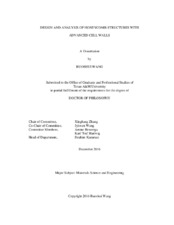| dc.description.abstract | Honeycomb structures are widely used in engineering applications. This work consists of three parts, in which three modified honeycombs are designed and analyzed. The objectives are to obtain honeycomb structures with improved specific stiffness and specific buckling resistance while considering the manufacturing feasibility.
The objective of the first part is to develop analytical models for general case honeycombs with non-linear cell walls. Using spline curve functions, the model can describe a wide range of 2-D periodic structures with nonlinear cell walls. The derived analytical model is verified by comparing model predictions with other existing models, finite element analysis (FEA) and experimental results. Parametric studies are conducted by analytical calculation and finite element modeling to investigate the influences of the spline waviness on the homogenized properties. It is found that, comparing to straight cell walls, spline cell walls have increased out-of-plane buckling resistance per unit weight, and the extent of such improvement depends on the distribution of the spline’s curvature.
The second part of this research proposes a honeycomb with laminated composite cell walls, which offer a wide selection of constituent materials and improved specific stiffness. Analytical homogenization is established and verified by FEA comparing the mechanical responses of a full-detailed honeycomb and a solid cuboid assigned with the calculated homogenization properties. The results show that the analytical model is accurate at a small computational cost. Parametric studies reveal nonlinear relationships between the ply thickness and the effective properties, based on which suggestions are made for property optimizations.
The third part studies honeycomb structures with perforated cell walls. The homogenized properties of this new honeycomb are analytically modeled and investigated by finite element modeling. It is found that comparing to conventional honeycombs, honeycombs with perforated cell walls demonstrate enhanced in-plane stiffness, out-of-plane bending rigidity, out-of-plane compressive buckling stress, approximately the same out-of-plane shear buckling strength, and reduced out-of-plane stiffness. For the future design, empirical formulas, based on finite element results and expressed as functions of the perforation size, are derived for the mechanical properties and verified by mechanical tests conducted on a series of 3D printed perforated honeycomb specimens. | en |


